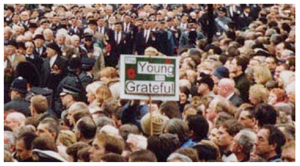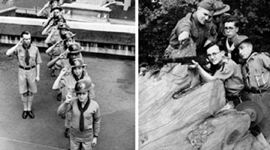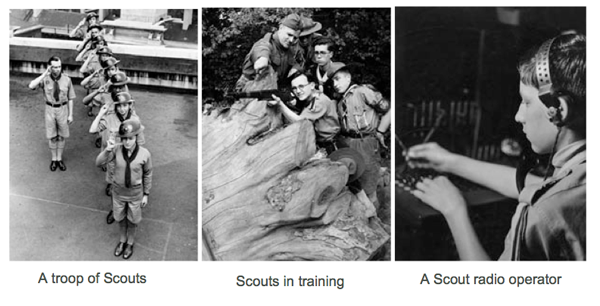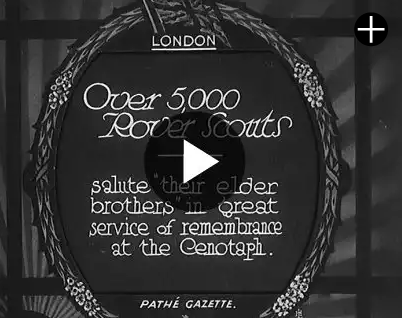Scouts at The Cenotaph.
Since 1922, there has been an Honour Guard of Queen’s Scouts (and formerly King’s Scouts) flanking the door from the Foreign & Commonwealth Office to the Cenotaph. There are no remaining written records in The Scout Association archives to tell us precisely the history of the first Honour Guard, but it is probable that the King’s Scouts were there at the request of King George V himself. (This text is from a BBC webpage that is no longer online.)
So, what exactly did Scouts do in the First and Second World Wars that qualifies them to mount an Honour Guard at the Foreign & Commonwealth Office to this day, and to stand to attention in front of the Queen, the Prime Minister, Cabinet Ministers and all the representatives of Commonwealth countries as they file past? Well, for a start, an enormous number of Scouts served in the armed forces, police force and fire service since 1908, and have been highly valued by their regiments and squadrons for their prior knowledge and training. Many Scouts served in ambulance units, air raid patrols, and other civilian services.
By the end of the World War 2 more than 60,000 Scouts had been awarded the National Service Badge for their work at home. They had worked as First Aid orderlies, signallers, telephonists, Air Raid Precaution (ARP) messengers, stretcher- bearers, Coast Watch, Home Guard instructors and Rest Centre assistants. They had made camouflage nets,
helped evacuate thousands of younger children from bombed city centres, harvested millions of tonnes of food and animal fodder, chopped wood on a massive scale (around 600,000 hours), and salvaged glass, metal and rubber for re-use.
 However, it was the service performed by Scouts during air raids and the Blitz on London that showed outstanding courage and application of the words of the Scout Promise and Law. 80 young Scouts were given Scouting gallantry medals, and in London, Coventry and Liverpool the Silver Cross (Scouting) was awarded to entire Troops. Individual Scouts were awarded the George Medal and George Cross. Fifteen Scouts just old enough to serve in the forces were awarded the Victoria Cross. One particular service Scouts gave to London was guiding fire engines in from the outskirts of the city by the quickest routes to blazing buildings. When they couldn’t get any closer to the fires because of the danger, the Scouts provided First Aid treatment and a barricade to stop others getting too close. In an air raid on Manchester, Scouts rushed burned and wounded firemen to hospital and returned to the scene to carry on their First Aid work. In many cases, older Scouts took over from Leaders who had joined up or been killed, in order to keep Troops together.
However, it was the service performed by Scouts during air raids and the Blitz on London that showed outstanding courage and application of the words of the Scout Promise and Law. 80 young Scouts were given Scouting gallantry medals, and in London, Coventry and Liverpool the Silver Cross (Scouting) was awarded to entire Troops. Individual Scouts were awarded the George Medal and George Cross. Fifteen Scouts just old enough to serve in the forces were awarded the Victoria Cross. One particular service Scouts gave to London was guiding fire engines in from the outskirts of the city by the quickest routes to blazing buildings. When they couldn’t get any closer to the fires because of the danger, the Scouts provided First Aid treatment and a barricade to stop others getting too close. In an air raid on Manchester, Scouts rushed burned and wounded firemen to hospital and returned to the scene to carry on their First Aid work. In many cases, older Scouts took over from Leaders who had joined up or been killed, in order to keep Troops together.
That’s just a small indication of the support and service given by Scouts at a time when their skills, training and team-spiritedness were called upon constantly. The uniform made them instantly recognisable as individuals who could be trusted to give directions or provide a focus in a crisis, such as an air raid. So, on the eleventh day of the eleventh month every year, Scouts march at the tail of the procession of veterans, alongside Guides and members of the Boys’ Brigade who have also provided civilian services to the public. From the 1930s until the late 1950s, London’s Rover Scouts had their own service and procession past the Cenotaph, and thousands came from all over the country to march.
[Youtube]http://youtu.be/E4I3YHVjV3w[/youtube]
Remembrance Sunday for Scouts isn’t about marching like soldiers or glorifying war. It’s about representing fellow Scouts who ‘did their best’ in frightening and dangerous circumstances for the sake of their community and their country. Last year, one lonely placard, waving above the heads of the crowd, read ‘The Young Are Grateful’.
Photos courtesy of The Scout Association
Click here to learn more about Beckenham War Memorial
Click below for Pathe Video
(opens in new tab)


